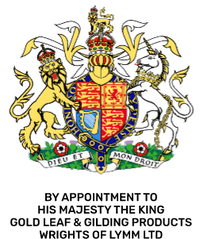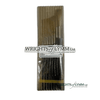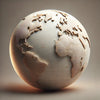Gold Leaf Across the World - Kuwait
- by Sam Wozniak
The History and Uses of Gold Leaf in Kuwait
In the oil-rich emirate of Kuwait, gold has long been more than just a metal: it has been a symbol of prestige, religion, wealth and identity. While much of the global gold-leaf story centres on Europe or Asia, Kuwait has its own unique narrative of gold leaf (often spelled “goldleaf”), of gilding, and of monumental applications of gold in architecture, interiors, restoration and cultural investments. This article traces how gold leaf—including high-purity versions such as 24 carat and the slightly more durable 23.5 carat gold leaf—has been used across Kuwait’s built heritage, decoration and restoration practices.
Early Traditions of Gold and Gilding in Kuwait
Kuwait’s traditional relationship with gold predates the oil boom. As early as the pearl-diving era and before large-scale hydrocarbon wealth, Kuwaiti society held gold jewellery, gold ornaments and trading in gold coins as part of social status and economic life. One analysis notes that jewellery forms such as the “Al Shahid ring”, the “Damaat Jaber” necklace and the heavy bridal gold of Kuwaiti weddings reflect how gold has long been integral to Kuwaiti identity.
Although much of this tradition refers to wearable gold rather than architectural gilding, the cultural value attached to gold facilitated the later adoption of gilding in built form and decorative arts. Gilding—or the craft of applying a thin sheet of gold (gold leaf) to a surface—is a universal technique. As explained broadly: “Gilding is the craft of applying gold leaf… to solid surfaces such as wood, stone, or metal…”
In Kuwait, this set the cultural conditions for using gold leaf in architecture, palaces and monumental works as built wealth grew dramatically in the 20th-century petroleum era.
Monumental Architecture and Gilded Surfaces
When it comes to truly monumental applications of gilding in Kuwait, one prominent example is Al‑Seif Palace in Kuwait City. The palace’s watch-tower roof is reportedly plated in “pure gold” as part of its decoration. While the specific karat of the gold planking is not always publicly detailed, such applications reflect a high-level gilding ambition in Kuwaiti architecture.
Another landmark is the Al Kuwait Towers, built in the 1970s. These towers symbolise Kuwait’s modern transformation, and while they do not appear to employ gold leaf per se on their spherical cladding, the “liquid gold” metaphor used to describe their oil-related symbolism underscores the cultural resonance of gold in Kuwait’s architectural ambition.
These examples indicate that in Kuwait’s built environment, gilding and gold finishes have been used to signify national wealth, modernity and prestige. The use of gold leaf or gold plating in monumental architecture thus becomes a visible marker of status—for governments, for public buildings, for interiors of power.
Gilding in Interiors, Decorative Arts and Cultural Spaces
Beyond public architecture, the craft of gilding (using gold leaf) has been employed in interiors, furniture, doors, frames, and decorative surfaces in Kuwait. Although academic literature specific to Kuwait’s gilding craft is less abundant compared to larger regions with deep gilding traditions, we can infer the practice through the importation of gilded materials and the availability of gilding supplies in Kuwait.
Even if many kits or small-scale decorative uses are imported and not strictly high-carat gilding for heritage, they show that gold leaf and gilding are used locally in crafts, restoration, interior design and luxury decoration.
Furthermore, the presence of museums such as the Tareq Rajab Museum (which houses a “Gold Room” of jewellery and objects) reminds us that gold—not just in leaf form but as material ornament—is part of Kuwait’s heritage.
In decorative arts and interiors, the choice between 24 carat gold leaf (maximum purity) or 23.5 carat may depend on considerations of durability, environmental conditions (e.g., high heat, humidity) and cost. In many gilding contexts globally, 23.75ct or 23.5ct gold leaf is chosen when slightly greater strength is needed, while 24 ct is used for top-level luxury or where tarnish-resistance is paramount.
Thus, in Kuwait, although documentation is limited, one may reasonably infer that high-end interior gilding in palaces, official buildings, and luxury residences may use 24 carat gold leaf, while more utilitarian gilding might use 23.5 carat.
Restoration, Preservation and Contemporary Gilding Trends
A particularly dynamic area in the gold leaf story of Kuwait is the restoration and heritage conservation of gilt surfaces, as well as the contemporary surge in luxury gilding applications. Globally, gilding restoration is recognised as a specialised conservation craft: “Gold leaf plays a crucial role in heritage preservation… ensuring that historical beauty is preserved.”
In Kuwait, heritage architecture is being increasingly valued. For example, one PhD thesis on Kuwaiti architecture explains that traditional buildings underwent renovation efforts, and that the architecture of Kuwait blends Islamic, Persian, Ottoman, and modern influences.
While specific case studies of gilt surface restoration in Kuwait are rare in publicly accessible literature, the presence of high-end building projects, mosques, and cultural centres means that gilding restoration is a likely element of heritage work. For example, a recent article mentioned a mosque in Kuwait (the “Golden Mosque”) using golden titanium, travertine and special materials—while not strictly gold leaf, it points to the golden aesthetic being embedded in new religious architecture.
Restoration-wise, when gilt surfaces degrade (due to abrasion, environmental stress, or ageing), particular care is required for repointing the substrate, reapplying adhesives, and laying fresh gold leaf. The high purity gold leaf (24 carat) may deliver the highest brilliance and longevity, but 23.5 carat may provide useful compromise for work that requires durability in challenging climatic environments—such as Kuwait’s heat, dust and occasional extreme weather.
Why 24 Carat vs 23.5 Carat Matters in Kuwaiti Gilding
When discussing gold leaf in architectural or heritage contexts, the difference between 24 carat and 23.5 carat is meaningful. Pure gold leaf (24 carat) offers maximum brilliance, rich colour, and high resistance to tarnish. In gilding terms, 24ct gold leaf is often used for the highest-level visible finishes—especially on interiors of importance, domes, altars, decorative ceilings, frames, and surfaces where longevity and appearance matter. Meanwhile, 23.5 carat (or similar high-karat alloys) offers slightly more mechanical strength or lower cost while preserving much of the colour and prestige.
In Kuwait’s context, given the harsh desert climate, exterior exposure, dust, and heat, using 23.5 carat gold leaf for certain surfaces may make sense from a durability standpoint, though 24 k would remain the top tier for prime visible surfaces or interiors of palaces, official buildings, and monumental architecture.
Gilding techniques themselves—whether water gilding or oil gilding—play a role in the finish and durability. Traditional water gilding allows the gold leaf to be burnished to a high sheen, but is more labour-intensive and often used for interiors. Oil gilding is more robust for some surfaces.
Thus, in Kuwait, for monumental works, the use of 24 carat gold leaf in official or ceremonial spaces may be expected, while 23.5 carat leaf may be more common in restoration, secondary surfaces or exterior decorative elements.
Cultural Symbolism and the Role of Gilding in Kuwaiti Identity
Gilding and gold leaf serve not only decorative ends, but also profound cultural symbolism in Kuwait. The wealth generated by oil, the strategic position in the Gulf, the traditions of gold jewellery and pearl-diving heritage—all provide context for why gold becomes a visible marker of prestige and national identity.
Public architecture and private palaces that incorporate gold leaf signal a continuity with the region’s history of luxury, the global circulation of materials (including gold), and Gulf aesthetics of opulence. In a society where gold jewellery still plays a key social role (for example in weddings), the extension of gold finish into architecture and interior design is a logical cultural manifestation.
Furthermore, as Kuwait expands its cultural and civic infrastructure (for example under Vision 2035), the inclusion of gilding in new mosques, cultural centres and restoration initiatives signals both a respect for tradition and a desire to present Kuwait as a prestige destination. In this sense, gilding becomes part of the broader narrative of heritage, tourism, luxury and national brand.
Challenges and Future Outlook for Gilding and Gold Leaf in Kuwait
Despite this rich interplay of culture and gold, there are practical challenges for gilding in Kuwait. The desert climate, extreme heat, dust storms, high UV exposure and occasional corrosion risk require careful material selection, substrate preparation and maintenance. The choice between 24 carat and 23.5 carat leaf, and between water vs oil gilding techniques, thus becomes important.
Also, heritage conservation frameworks in Kuwait are still evolving. While some historic buildings and markets (such as Souq Al‑Mubarakiya) are being preserved, many mid-20th-century architectural landmarks face demolition or alteration. This trend means that opportunities for restoration of gilded surfaces may be either lost or require significant funding and skilled craftsmanship.
Looking ahead, the future of gilding and gold leaf in Kuwait appears promising. With growth in luxury construction, cultural projects, museum restoration, and interior high-end design, demand for gilding expertise is likely to rise. New mosques, government buildings and elite residences may increasingly incorporate gold leaf finishes, both for aesthetic and symbolic value. The availability of high-karat gold leaf materials and professional gilding/restoration services globally means that Kuwait’s gilding opportunities are aligned with international best practices.
At the same time, the emphasis on sustainability and cost-effectiveness may push a balance between using genuine 24 carat gold leaf for prime surfaces and slightly lower karat alternatives (such as 23.5 carat) for secondary surfaces. The training of artisans in traditional gilding techniques, substrate preparation, and restoration crafts will be key to preserving gilded heritage within Kuwait’s accelerating development environment.
Conclusion
From the early traditions of gold-jewellery in Kuwaiti social life to the monumental gilded roofs of palaces, the interior craftsmanship of elite residences, and the restoration of heritage architecture, gold leaf (goldleaf) and gilding have played a substantive role in Kuwait’s built and cultural environment. The use of 24 carat gold leaf represents the highest level of luxury and durability, while 23.5 carat gold leaf offers a pragmatic variant suited to challenging conditions or secondary surfaces.
In Kuwait today, gilding remains a marker of prestige and heritage, and as construction, restoration and cultural investment continue apace, the craft of gilding is likely to deepen its imprint on Kuwait’s architecture and interiors. Restoring the past and creating the future, gilding in Kuwait is both a literal and symbolic golden thread weaving through identity, space and material culture.






